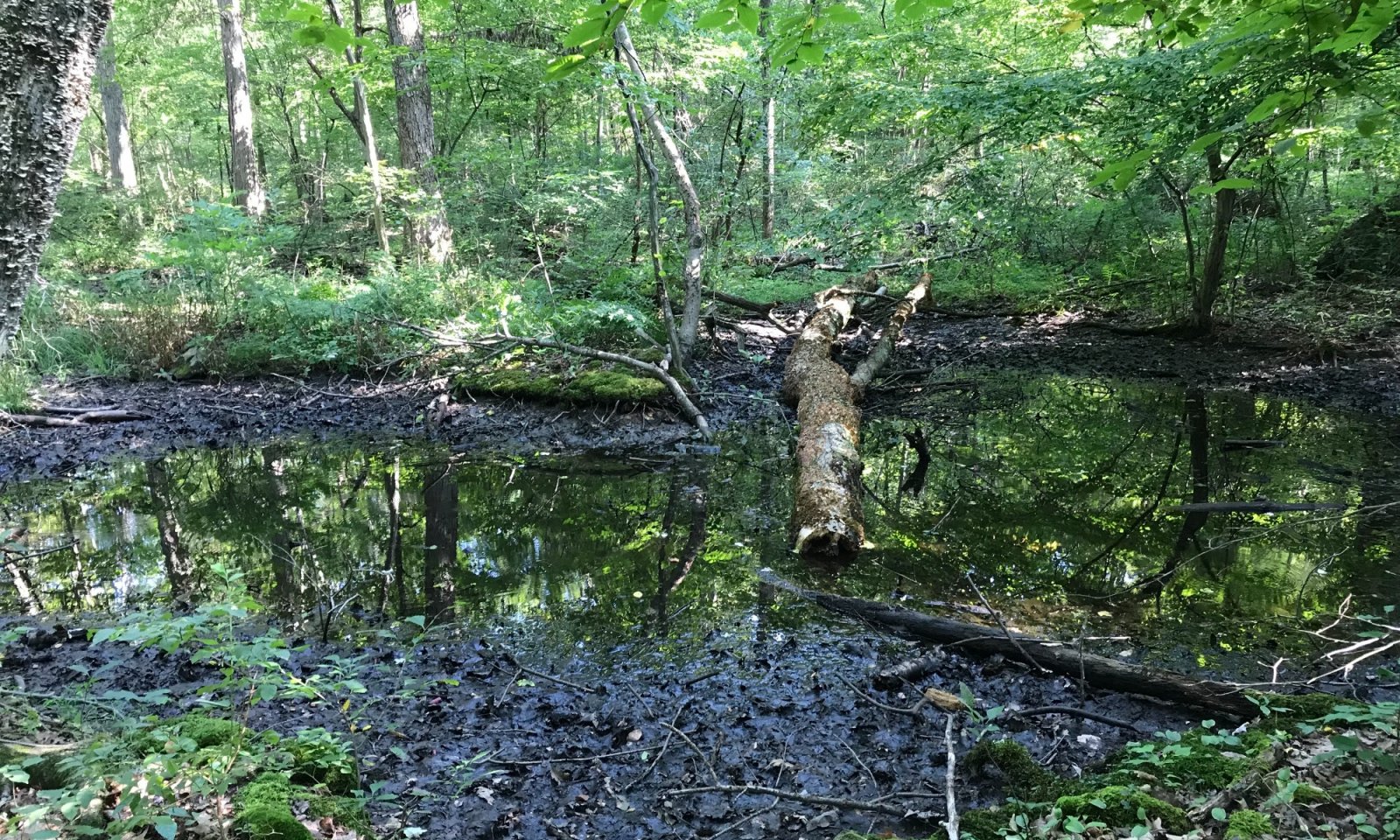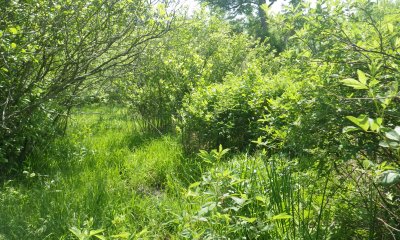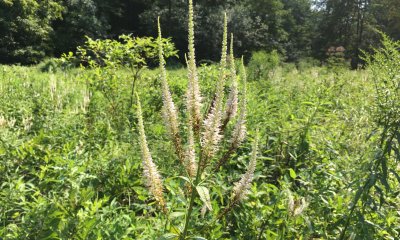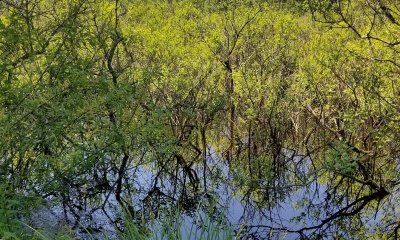
Hydric, Piedmont - felsic, Riparian Zone, Swamp Meadow-Shrub-Forest
Scenario model
Current ecosystem state
Select a state
Management practices/drivers
Select a transition or restoration pathway
- Transition T1 More details
- Transition T4 More details
- Transition T5 More details
- Restoration pathway R1 More details
- Transition T2 More details
- Transition T6 More details
- Restoration pathway R2 More details
- Transition T3 More details
- Restoration pathway R3 More details
-
No transition or restoration pathway between the selected states has been described
Target ecosystem state
Select a state
Submodel
Submodel
Submodel
Mechanism
This transition pathway can occur as a result of any disturbance that directly impacts an existing forest tree canopy. Examples include abnormal flooding events and/or changes to hydrology which cause increased duration and depth and flooding, increased flood energy and scour, deposition of significant flood transported material, ice, wind, insects, disease, and timber extraction.
Relevant conservation practices
| Practice | External resources |
|---|---|
|
Early Successional Habitat Development/Management |
|
|
Forest Stand Improvement |
Mechanism
This transition pathway can occur as a result of any disturbance that directly impacts established woody vegetation including both trees and brush. Examples include abnormal flooding events and/or changes to hydrology which cause increased duration and depth and flooding, increased flood energy and scour, deposition of significant flood transported material, ice, wind, insects, and disease
Context dependence
Some wildlife habitat management objectives (or other objectives) might call for the reduction of woody vegetation and the enhancement of herbaceous meadow vegetation, so this transition can potentially be a restoration as well.
Relevant conservation practices
| Practice | External resources |
|---|---|
|
Brush Management |
|
|
Early Successional Habitat Development/Management |
|
|
Forest Stand Improvement |
|
|
Prescribed Grazing |
Mechanism
This transition pathway can occur as a result of any disturbance that changes hydrology and creates increased depth and duration of ponding of water on the soil surface.
Constraints to recovery
Recovery would require significant hydrologic restoration
Relevant conservation practices
| Practice | External resources |
|---|---|
|
Wetland Restoration |
|
|
Wetland Creation |
|
|
Wetland Enhancement |
Mechanism
This restoration pathway is a normal successional pathway that can occur in the absence of high-energy flooding with scour, in the absence of flooding with high rates of deposition, and with a stable hydrologic regime. The normal successional pathway on these sites is towards wet forest conditions. Soil and hydrologic conditions may resist succession, even for long periods of time. However, shrubland conditions ultimately create an increasing abundance of microsites suitable for the recruitment of trees. Some type of tree killing disturbance is typically necessary to reverse that trend of increasing tree cover.
Relevant conservation practices
| Practice | External resources |
|---|---|
|
Brush Management |
|
|
Riparian Forest Buffer |
|
|
Tree/Shrub Establishment |
|
|
Herbaceous Weed Control |
Mechanism
This transition pathway can occur as a result of any disturbance that directly impacts established woody vegetation including both trees and brush. Examples include abnormal flooding events and/or changes to hydrology which cause increased duration and depth and flooding, increased flood energy and scour, deposition of significant flood transported material, ice, wind, insects, and disease.
Context dependence
Some wildlife habitat management objectives (or other objectives) might call for the reduction of woody vegetation and the enhancement of herbaceous meadow vegetation, so this transition can potentially be a restoration as well.
Relevant conservation practices
| Practice | External resources |
|---|---|
|
Brush Management |
|
|
Early Successional Habitat Development/Management |
|
|
Prescribed Grazing |
Mechanism
This transition pathway can occur as a result of any disturbance that changes hydrology and creates increased depth and duration of ponding of water on the soil surface.
Constraints to recovery
Recovery would require significant hydrologic restoration
Mechanism
This restoration pathway is a normal successional pathway that can occur in the absence of high-energy flooding with scour, in the absence of flooding with high rates of deposition, and with a stable hydrologic regime. The normal successional pathway on these sites is from wet meadow to wet shrubland and ultimately towards wet forest conditions. Soil and hydrologic conditions may resist succession, even for long periods of time. However, wet meadow conditions ultimately create an increasing abundance of microsites suitable for the recruitment of trees and shrubs. Some type of woody vegetation killing disturbance is typically necessary to reverse that trend of increasing woody cover. Some wildlife habitat management objectives (or other objectives) might call for the reduction of woody vegetation and the enhancement of herbaceous meadow vegetation, so some management objectives will be designed to resist this "restoration" pathway.
Relevant conservation practices
| Practice | External resources |
|---|---|
|
Riparian Forest Buffer |
|
|
Tree/Shrub Establishment |
|
|
Early Successional Habitat Development/Management |
Mechanism
This transition pathway can occur as a result of any disturbance that changes hydrology and creates increased depth and duration of ponding of water on the soil surface.
Constraints to recovery
Recovery would require significant hydrologic restoration
Relevant conservation practices
| Practice | External resources |
|---|---|
|
Wetland Restoration |
|
|
Wetland Creation |
|
|
Wetland Enhancement |
Mechanism
This restoration would require significant hydrologic restoration.
Relevant conservation practices
| Practice | External resources |
|---|---|
|
Riparian Herbaceous Cover |
|
|
Early Successional Habitat Development/Management |
Model keys
Briefcase
Add ecological sites and Major Land Resource Areas to your briefcase by clicking on the briefcase (![]() ) icon wherever it occurs. Drag and drop items to reorder. Cookies are used to store briefcase items between browsing sessions. Because of this, the number of items that can be added to your briefcase is limited, and briefcase items added on one device and browser cannot be accessed from another device or browser. Users who do not wish to place cookies on their devices should not use the briefcase tool. Briefcase cookies serve no other purpose than described here and are deleted whenever browsing history is cleared.
) icon wherever it occurs. Drag and drop items to reorder. Cookies are used to store briefcase items between browsing sessions. Because of this, the number of items that can be added to your briefcase is limited, and briefcase items added on one device and browser cannot be accessed from another device or browser. Users who do not wish to place cookies on their devices should not use the briefcase tool. Briefcase cookies serve no other purpose than described here and are deleted whenever browsing history is cleared.
Ecological sites
Major Land Resource Areas
The Ecosystem Dynamics Interpretive Tool is an information system framework developed by the USDA-ARS Jornada Experimental Range, USDA Natural Resources Conservation Service, and New Mexico State University.






